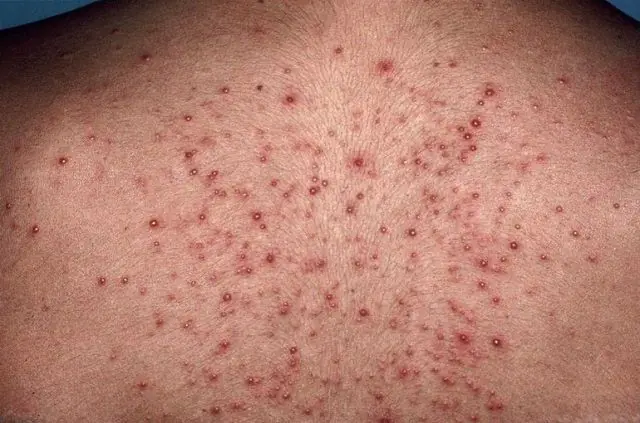- Symptoms
- Causes
- Diagnostics
- Treatment
- Eosinophilic folliculitis in HIV infection (AIDS)
Eosinophilic folliculitis is a serious disease that causes a painful rash in the form of pustules and papules with severe, frequent itching. The disease is also known as eosinophilic pustular folliculitis or eosinophilia. Mainly affects carriers of HIV infection. The rash often resembles regular acne, which often causes doctors to misdiagnose it. The disease can be diagnosed by biopsy. After the rash heals, scars remain that may not go away for a long time.
Symptoms of eosinophilic folliculitis
Eosinophilic folliculitis in the initial stage
The most common symptoms of eosinophilic folliculitis are:
- The disease mainly affects the upper part of the body. Main areas: face, neck, torso, chest and scalp. In rare cases, lesions may occur on the palms and soles of the feet, even though there are no hair follicles in these areas. In children, the follicles of the scalp, particularly the crown, are affected.
- Different types of bumps: swellings, papules, pustules.
- Skin lesions are concentrated on the hair follicles.
- All forms of folliculitis are accompanied by intense itching.
- The lesions are red, but can sometimes be skin-colored.
- Papules reach 20–50 mm in diameter.
- At the initial stage, the rash looks like ordinary acne, so the disease goes undetected for a long time.
Rarely, urticaria occurs, in which the lesions become red and irritated. These are atypical cases and most often appear in newborns.
Scratching pimples leads to damage to the skin, which leads to infection. The bumps fill with red pus and can spread to other areas of the body. After the lesion heals, scars remain on the skin. Internal organs are not affected.
Causes of eosinophilic folliculitis
Eosinophilic folliculitis is rare. It is mainly observed in HIV-infected people due to viral infections or autoimmune processes. The disease can also affect cancer patients and infants who are susceptible to drugs. Additionally, the most common causes of eosinophilic folliculitis may include:
- Long-lasting dermatitis, especially if the rash is very itchy and the skin is scratched.
- Immunodeficiency, hyperimmunoglobulinemia E syndrome, Sezary syndrome.
- Silicone breast augmentation.
- Bone marrow transplantation.
- Stem cell transplantation.
At the same time, a recent study found that if no secondary causes were found, but eosinophilic folliculitis appeared, then the culprit of the development is the demodex follicular mite. According to another study, this change in the immune system leads to aggression of eosinophils in the sebaceous glands.
- Read the folk recipe: chamomile for folliculitis
Diagnosis of eosinophilic folliculitis
Diagnosis of eosinophilic folliculitis is the very first important step in proper treatment. The disease is diagnosed using:
- Skin biopsies. The procedure identifies eosinophils in the area of the hair follicle.
- Clinical tests that reveal the initial assessment of the patient's condition.
- A blood test that detects an increase in the number of eosinophilic cells.
Treatment of eosinophilic folliculitis
There is no specific therapy for eosinophilic folliculitis. At the same time, treatment started on time will significantly help in recovery. Treatment methods depend on the type of eosinophilic folliculitis:
- Once the diagnosis is confirmed, a glucocorticoid-based ointment may help.
- A steroid cream is recommended to reduce discomfort.
- Antihistamines and anti-inflammatory drugs help reduce inflammation.
- Antiretroviral therapy is often used for patients with weak immune systems.
- Since recent studies have shown that mites and bacteria can cause eosinophilic folliculitis, other medications have begun to be included in the treatment plan: antibiotics, antifungals and antimicrobials. If the mite infects the hair follicle, medications for subcutaneous mites are recommended.
- For inflammatory conditions, calcineurin inhibitors are prescribed to reduce the immune system's response.
- When a secondary bacterial infection occurs, antibiotics are prescribed, Metronidazole tablets are often prescribed.
- For severe itching, antihistamines are indicated.
- Topical application of Tacrolimus can suppress the immune system response.
- Antifungal drugs - Itraconazole.
Retinoids and corticosteroids should only be taken under medical supervision as they can cause serious side effects with long-term use. Colchicine is recommended for people suffering from gout; it has a powerful anti-inflammatory effect.
In the treatment of eosinophilic folliculitis, as with oily folliculitis, phototherapy is effective, that is, ultraviolet: UVB and UVA light (prescribed in combination with taking psoralen). However, they cannot be used for a long time, otherwise serious side effects will occur. It is recommended to carry out the procedure three times a week.
Eosinophilic folliculitis in HIV infection (AIDS)
The photo shows eosinophilic folliculitis in an HIV-infected person
In people with HIV infection, eosinophilic folliculitis is accompanied by a chronic pruritic dermatosis of unknown etiology. It is characterized by erythematous, follicular, urticarial papules. Localization of rashes: neck, head, torso and upper limbs. The elements of the rash do not merge and sometimes resemble arthropod bites. The disease is accompanied by an increase in IgE levels, eosinophilia in the peripheral blood and worsening HIV infection (CD4 count < 250 cells/mm3). Bacterial cultures are ineffective. The rash is difficult to treat with antistaphylococcal drugs. Local treatment is carried out with potent corticosteroids, antihistamines, Itraconazole and BUV irradiation. In most cases, the disease gradually resolves.
- Related article: Drug treatment of chronic folliculitis



